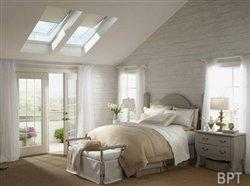Greenest of the green: Top efficiency-boosting home improvements
(BPT) - Forget wondering who’s the fairest; when it comes to choosing home improvements that make your home look good – from the curb and to potential buyers – it may make more sense to ask “Who’s the greenest of them all.” Sustainable home improvements not only help reduce utility costs and boost owner satisfaction with their homes, they also make a house more appealing to potential buyers.
In fact, buyers are willing to shell out up to 10 percent more for new homes certified green, according to a January real estate report by Harvard University. Return on investment for certain types of green improvements – such as replacing older, less efficient doors and windows – also tends to be high, meaning sellers recoup much of the initial cost of the improvement when they sell the home.
If you’re looking for eco-friendly home improvements, these five are among the greenest you can make:
1. Switch to a solar water heater – Switching to solar power for heating water can be a huge energy and money-saver. Solar hot water systems rely on free energy from the sun to heat a home’s hot water. A typical system can use 50 to 80 percent less energy than traditional heating systems, according to Velux America, marketers of solar-powered hot water systems. That reduction can help a typical household trim its annual energy costs by 10 to 15 percent.
“While the initial cost of installing a solar-powered system is often higher than installing a traditional water heater, most homeowners find the energy savings allows them to recoup that cost in just a few years,” says Jim Cika of solar system manufacturer Heliodyne. “What’s more, homeowners may qualify for a federal tax credit of up to 30 percent of the cost to buy and install a residential solar water heating system.” Visit www.solar.veluxusa.com to learn more about solar water heating.
2. Eliminate incandescents – You’ll have to do it soon anyway, so it may pay to start the process now and phase incandescent light bulbs from your home. Federal law banning incandescent light bulbs means that by the end of 2014, you probably won’t be able to find one of the old-fashioned power-guzzlers on store shelves anymore. Instead, more energy-efficient bulbs such as LEDs and compact fluorescent bulbs (CFLs) will dominate the marketplace.
3. Add or upgrade a skylight – Installing a skylight, or replacing an older model skylight with a new Energy Star-qualified one, can help reduce utility costs. The natural light from a skylight can help reduce the need for artificial light sources, thereby paring down electricity costs. When you pair no leak solar-powered fresh air skylights equipped with automatic rain sensors and efficiency-enhancing, energy saving accessories like designer solar powered blinds, you gain a new source of fresh air while improving energy efficiency by up to 37 percent, according to skylight manufacturer Velux.
And, in addition to long-term savings, the cost of solar powered skylights and blinds, as well as installation costs, are eligible for a 30 percent federal tax credit as a green home improvement. For a tax calculator that will show you the tax benefits of new or replacement skylights for your home visit www.veluxusa.com.
And, if you would like to see exactly how skylights would look in your home, there’s an app there that allows you to take pictures inside your home and superimpose skylights and blinds on the image of your ceiling.
Sunlight entering the home through a skylight can help reduce winter heating bills. EnergyStar.gov says installing an EnergyStar-qualified skylight, windows and doors can trim a home energy bill by 7 to 15 percent over non-qualified products. Visit www.EnergyStar.gov to learn more.
4. Replace an old HVAC system – In the typical American home, up to half of total energy consumption goes to heat and cool the house, EnergyStar says. Replacing old, inefficient heating, ventilation and cooling systems with newer, more efficient models can dramatically reduce a home’s heating and cooling costs.
5. Upgrade old windows and doors – A home can lose a tremendous amount of air – hot in the winter, cool in the summer – through poorly sealed doors and windows. Older units, obviously, tend to be less energy efficient than newer ones. Upgrading from drafty windows and doors to more air-tight models can result in significant savings on your heating and cooling costs.
What’s more, replacing windows and doors are among the home improvements that deliver significant ROI at the time of resale. Replacing old windows with new vinyl ones can recoup more than 71 percent of the cost when you sell; 73 percent for wooden replacement windows, according to Remodeling Magazine’s Cost vs. Value Report. And installing a new front door earns you back nearly 66 percent for a fiberglass door and a whopping 85.6 percent for a steel door.























